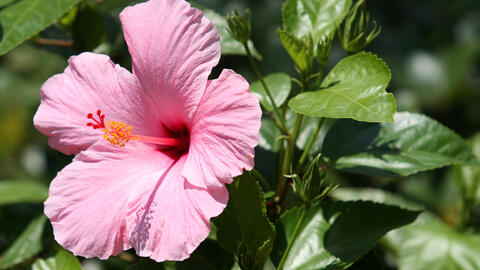Hibiscus: hardy or tropical?
The Hibiscus genus includes both hardy and tropical species. This should also be reflected in the plant’s winter protection. Find out how to best see the different species through winter.

Hibiscus flowers bring a touch of the exotic to the garden
Whether Hibiscus is hardy or tropical depends on which species it is. The genus Hibiscus includes hundreds of different species, which grow naturally in tropical and subtropical regions of the world. However, only a few species are particularly popular in this country and therefore widely available: Rose of Sharon (Hibiscus syriacus), Brilliant (Hibiscus rosa-sinensis) and Swamp Rose Mallow (Hibiscus x moscheutos). To ensure that your plant comes through winter unscathed, you need to know exactly what type of hibiscus you have.
The Chinese Hibiscus is one of the tropical Hibiscus species. With luxuriant flowers, it exudes exotic flair in summer in pots on the balcony or patio, but needs to be moved into winter quarters as soon as the outdoor temperature drops below 54 degrees Fahrenheit. Before taking it indoors, you should carefully check your Hibiscus for pests to avoid any nasty surprises at a later stage, and so that you can remove any dead or wilted parts of the plant. The Chinese Hibiscus can then overwinter in a bright room at a temperature of 54 to 59 degrees Fahrenheit. The best spots are a cool conservatory or a heated greenhouse.
Watch out for "warm feet", elevate the hibiscus slightly above stone floors by, for example, putting it on a Styrofoam disc or clay pot feet. A spot close to the window or light is ideal, while putting the plant directly next to a radiator or heater may cause the Hibiscus to shed its leaves. Moreover, too dry air quickly leads to pest infestation and brown edges on leaves. You should therefore ventilate the plant regularly when the weather is good. In addition, water-filled trays and containers contribute to a higher air humidity, which is very beneficial for the Hibiscus in its winter quarters.

During the Hibiscus hibernation period, it is important to water the Hibiscus only moderately so that the root ball does not dry out completely, and to refrain from fertilizing it completely. You can steadily increase watering in spring and feed the Chinese Hibiscus every two weeks with a fertilizer for potted plants. The Hibiscus can be taken outdoors from April/May, when there is no longer a risk of night frost
In contrast to the Chinese Hibiscus, you can plant rose of Sharon in the garden and leave it there even in winter. For some varieties, the older plants are hardy up to -4 degrees Fahrenheit. However, young plants need to be protected from the cold and frost in the first three to four years. Cover the root area of the Hibiscus with a thick layer of bark mulch, leaves or fir tree branches.

Rose of Sharon cultivated in a pot should be placed against a protected south wall of the house during the winter. The bucket or pot should be covered with burled foil, jute or fleece, the root area should also be covered with a layer of leaves or brushwood and the pot should be placed on a wooden or polystyrene base. This also ensures the plant has the necessary insulation at the base.
Swamp Rosemallow varieties are something of an insider’s tip, their flowers are almost prettier than those of Chinese Hibiscus or Rose of Sharon – they do, after all, have a flower diameter of up to 12 inches! If you choose this herbal member of the Hibiscus genus, you can look forward to the winter with confidence: Swamp Rosemallow is fully hardy and can withstand temperatures of up to -22 degrees Fahrenheit without any winter protection. The shrubs can reach heights of up to 6.5 feet. In fall, simply cut them back almost to ground level and new growth reliably appears the following May.



